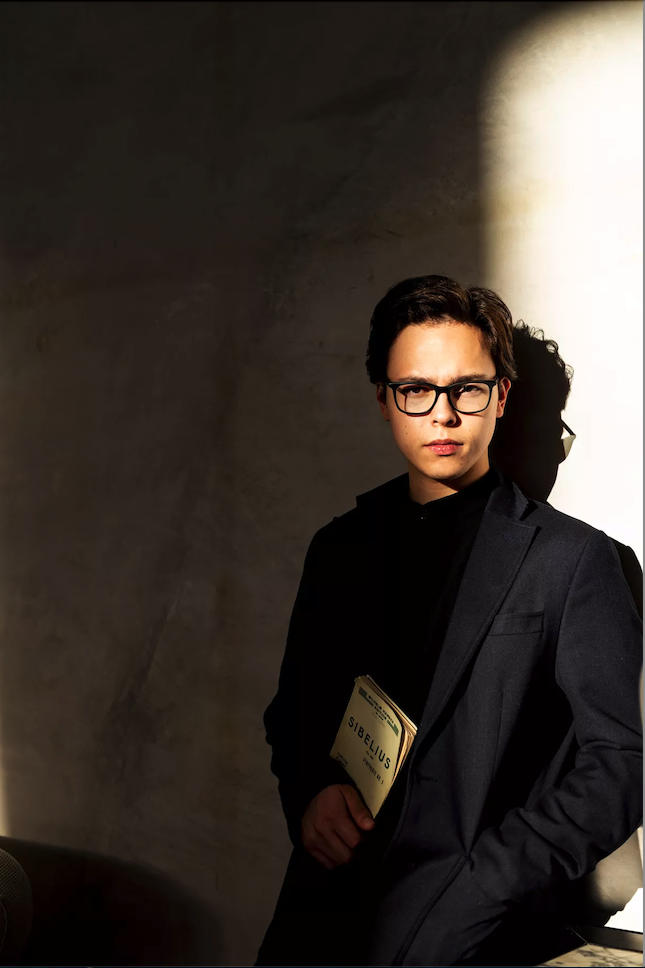The San Diego Symphony Celebrates the Riches of Finnish Music
Thursday’s San Diego Symphony program at the California Center for the Arts should have been titled A Celebration of Finnish Music. On the podium, the young Finn Tarmo Peltokoski made his smashing local conducting debut with a program largely devoted to music by his own people.
He opened with a short but beautifully structured tone poem, Ciel d’hiver (Winter Sky) by Kaija Saariaho, Finland’s preeminent contemporary composer, and he devoted the concert’s second half to the mighty Symphony No. 2 in D Major by Jean Sibelius, Scandinavia’s preeminent composer of the early 20th century. Between these two Finnish entrees, the audience was treated to a bit of refreshing sorbet, Mozart’s Third Violin Concerto, K. 216, with Concertmaster Jeff Thayer as soloist.While I am always captivated by Saariaho’s music, her Neo-Impressionism suggests to me Debussy on ice. If his source of La Mer was the turbulent Atlantic, but I would posit that Saariaho’s comparable sea is the icy Baltic. Ciel d’hiver opens with an orchestra of suppressed murmurs, a static block of sound that incrementally grows in volume over the extent of the piece. Early on we hear the deft flight of a modal piccolo solo, followed by other tentative wind themes that float over the orchestra, as well as low brass pedal tones that build up the dynamic level from the bass.
The full orchestra’s sonic climax surfaces unexpectedly while the listeners are distracted by assertive rumbling from the timpani and glinting harp glissandos, but the solid forte dissolves quickly, and Saariaho’s sounds slip away like embarrassed party guests.
Peltokoski’s conducting authority proved both secure and understated, appropriate to this score. The vastly wider emotional scope of the Sibelius Symphony, of course, required more detailed attention and physical engagement from the conductor, which he provided amply, especially in the bold, triumphant Finale.
Conducting the Sibelius from memory—perhaps conducting majors from Helsinki’s famed Sibelius Academy are required to memorize his symphonies—Peltokoski’s command of the Second Symphony was nothing short of brilliant. A busy, complex score that displays impatience with the structural niceties of sonata form, the Second Symphony is always on the verge of chaos, yet the young Finn managed the thematic labyrinths of the middle movements majestically, and the Finale came home securely like a massive ocean liner securely docking into its berth. From the orchestra he coaxed a radiant, blooming sonority that filled Escondido’s welcoming hall with some of the San Diego Symphony’s most attractive, rewarding ensemble sound I have heard in a long time.
I cannot say that Mozart’s five violin concertos reside anywhere near the top of my list of favorite solo concertos, and they certainly pale in comparison to the thrill and invention of his 27 piano concertos. But Concertmaster Jeff Thayer gave a carefully detailed account of Mozart’s Violin Concerto No. 3 in G Major, K. 216, with every note in its place and every phrase thoughtfully considered. Thayer tends to be a cool performer, however, and his reserve did not do this performance any favors.
All the notes were there, but what was Mozart communicating? As I heard the concerto, Thayer was not divulging much. When the orchestra came in, Peltokoski attempted to raise the temperature of the room, but he could not save the day.
This concert by the San Diego Symphony was performed on February 2, 2023 at Escondido’s California Center for the Arts and will be repeated on February 3, 2023, at Chula Vista’s Southwestern College.

Ken Herman, a classically trained pianist and organist, has covered music for the San Diego Union, the Los Angeles Times’ San Diego Edition, and for sandiego.com. He has won numerous awards, including first place for Live Performance and Opera Reviews in the 2017, the 2018, and the 2019 Excellence in Journalism Awards competition held by the San Diego Press Club. A Chicago native, he came to San Diego to pursue a graduate degree and stayed.Read more…

